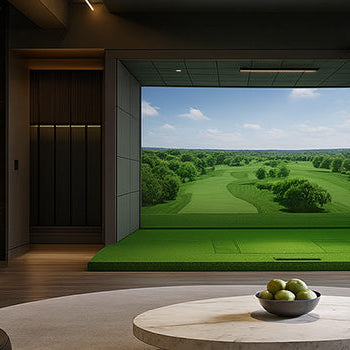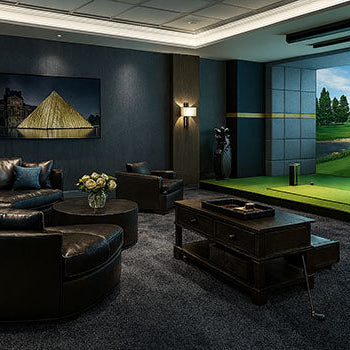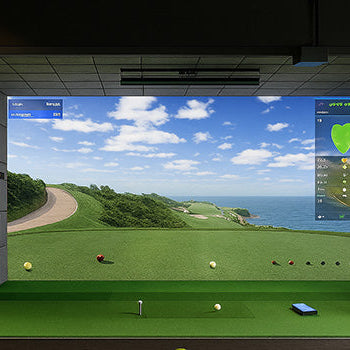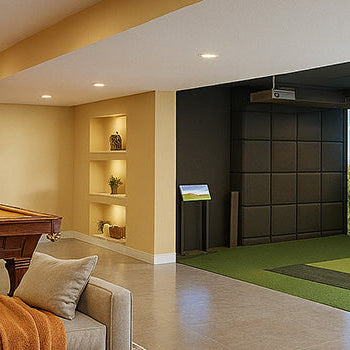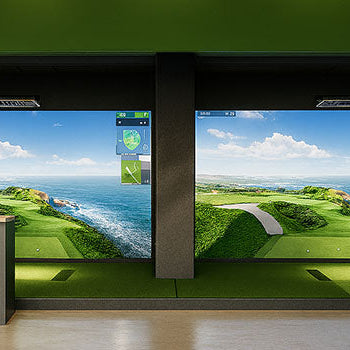Short answer: stand about 8–10 feet from your Golf Simulator for safe, accurate practice. But before you start swinging in your living room, let’s make sure you’re not sending golf balls ricocheting into your TV. There’s more to getting your setup right than just “pick a corner and swing away.” Those few feet matter. A lot.
Let’s break it down so you can create a practice space that’s safe, realistic, and actually helps you improve your game.

Understanding the Key Distances for Safety and Function
It's a Question of Two Key Measurements, Not Just One
When people ask how far should you hit from a golf simulator, they often forget: it's not just about the screen.
There are two crucial measurements you need to get right:
Miss one of those and you're setting yourself up for poor tracking, or worse, a busted wall or bruised ego.
Distance 1: The Hitting Area to the Impact Screen
This is the space the ball needs to fly before it hits the screen or net. Too short? You’ll get bounce-back. Too far? Your launch monitor might miss vital data.
Most setups aim for that perfect middle ground.
Distance 2: The Hitting Area to the Back Wall
This is the space behind you, the room you need to swing comfortably, especially with a driver. Don’t just eyeball it. If you can’t take a full swing without adjusting your stance or shortening your backswing, you're too close to the wall.
Why These Distances are Crucial for Safety and Accuracy
This isn’t just about comfort, it’s about performance. A tight space can lead to awkward swings, bad ball data, and even damage to your surroundings.
Proper spacing keeps your equipment safe, your shots accurate, and your practice effective. And that’s what turns a "fun toy" into a true training tool.
Distance 1: How Far to Stand from the Impact Screen
The Ideal Range: 3m to 3.6m (10ft to 12ft)
This is the golden zone. If you’re wondering how far away do you stand from a golf net or impact screen, the ideal range is 3 to 3.6 metres (10–12 feet).
This distance gives your ball enough room to travel without bouncing back and allows most launch monitors, especially radar and photometric systems, to track your swing properly.
Too close and you risk ricochet. Too far and you lose accuracy.
The Main Reason: Safety from Ball Bounce-Back (Ricochet)
Let’s be honest, no one wants a golf ball coming back at them like a boomerang.
Standing around 8–10 feet away helps absorb the ball’s energy on impact, especially if you’re using higher-tension screens. And trust us, ricochet hurts, physically and emotionally.
The Minimum "Safe" Distance: Approximately 2.5m (8ft)
If space is tight, you can make it work at 2.5 metres (8 feet). But it’s really the bare minimum.
Any closer, and you’re playing a risky game. A powerful shot could bounce back unexpectedly, especially with lower-quality netting or impact material.
How Screen Tension and Quality Affects This Distance
Here’s the deal: not all screens are created equal.
-
High-tension screens absorb more impact, reducing bounce.
-
Cheaper nets or loosely hung screens? They’ll send the ball right back at you.
So if you're planning to get closer than 10 feet, invest in a quality impact screen that’s designed to take the hit.

Distance 2: How Much Space You Need Behind You
The Golden Rule: Enough Room for a Full, Unhindered Driver Swing
We’ve all seen it, someone trying to tee off in their garage only to knock over a shelf or clip the ceiling.
You need enough space behind you to swing freely, especially with a driver. If you're adjusting your swing to avoid hitting the wall, you're defeating the purpose of practicing indoors.
The Comfortable Recommendation: 2m to 2.5m (7ft to 8ft) of Clear Space
The sweet spot? 2 to 2.5 metres (7–8 feet) from your back foot to the nearest wall or obstacle.
That gives you enough clearance to go full throttle with your swing, driver, wedge, whatever. No holding back, no second-guessing.
The Absolute Minimum: Approximately 1.8m (6ft)
If you’re really short on space, 1.8 metres (6 feet) might be doable. But it’s tight.
Anything less and your swing gets compromised, especially if you're tall or use longer clubs.
How Launch Monitor Choice Affects This (Radar vs. Camera Systems)
Here’s where tech matters.
-
Radar-based launch monitors (like TrackMan) sit behind you and need extra space to read ball flight.
-
Camera-based systems (like SkyTrak or GCQuad) are placed beside or in front of the ball, so they’re more compact-friendly.
If you’re working with limited room, go for a camera system to save space behind the hitting zone.
The "Hidden" Third Distance: Space Behind the Screen
Why Your Screen Needs a Buffer Zone
This one’s easy to overlook, but crucial. You need to leave space behind your screen or golf net.
Why? Because the screen moves when hit. If it’s flush against a wall, it has nowhere to go. That’s a recipe for dented drywall or worse.
The Recommended Gap: At Least 30cm (1ft) from the Wall
Give your screen at least 30cm (1 foot) of breathing room.
This lets it absorb the shot properly without slamming into the back wall. Bonus: it protects both your screen and your house.
How This Prevents Wall Damage and Reduces Ricochet
When a screen has space to flex, it can slow down the ball more naturally.
Less bounce-back. Less wall damage. More peace of mind. It’s a small detail that makes a big difference.
Summary: A Quick-Reference Distance Guide
Behind the Screen: 30cm+
Leave a 30cm+ (1 foot) gap between the screen/net and the wall for safety.
Screen to Hitting Area: 3m
Stand 3 metres (10 feet) from the screen or net for ideal performance and safety.
Hitting Area to Back Wall: 2.5m
Give yourself 2.5 metres (8 feet) behind the hitting mat to swing confidently.
Total Ideal Room Depth: Approximately 5.5m - 6m
For a full setup that doesn't compromise safety or tracking, aim for 5.5 to 6 metres (18–20 feet) of total depth in your room.

Frequently Asked Questions About Placement
What happens if I stand too close to the screen?
Bounce-back. Bad data. Possible bruises. Standing too close increases the chance of the ball rebounding, and your launch monitor might misread the shot.
What happens if I stand too far from the screen?
You might lose tracking accuracy, especially with photometric launch monitors. And if you’re using a projector, the image could shrink or get distorted.
Do these distances change for wedges vs. drivers?
A little, yes.
Wedges fly slower, so you can get away with slightly less distance. Drivers need more room. But for consistency, it’s best to set one standard hitting distance and stick with it, no matter the club.
